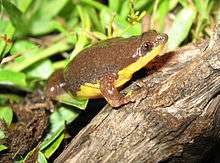Elachistocleis bicolor
| Elachistocleis bicolor | |
|---|---|
 | |
| Scientific classification | |
| Kingdom: | Animalia |
| Phylum: | Chordata |
| Class: | Amphibia |
| Order: | Anura |
| Family: | Microhylidae |
| Genus: | Elachistocleis |
| Species: | E. bicolor |
| Binomial name | |
| Elachistocleis bicolor (Guérin-Meneville, 1838) | |
Elachistocleis bicolor (common name: two-colored oval frog, Spanish: rana pinguino or sapito panza amarilla) is a species of frog in the family Microhylidae. It is found in central Argentina and northward through Paraguay and Uruguay to Amazonian Brazil; earlier reports from Bolivia probably refer to Elachistocleis haroi.[2]
Habitat
Elachistocleis bicolor is an abundant species occurring in seasonally flooded grasslands and in dry and moist forests. It can also survive in rural gardens and urban areas.[1]
Description
Elachistocleis bicolor are nocturnal and semi-fossorial in their lifestyle. During periods of aestivation, they can be found inside ant and termite nests.[3] Male Elachistocleis bicolor grow to a snout–vent length of 23–32 mm (0.91–1.26 in) and females to 27–36 mm (1.1–1.4 in). Its name refers to its striking colour pattern with brownish back and yellowish dorsum.[4]
Elachistocleis bicolor feed primarily on ants[1] and termites, with other insects making minor contributions to their diets. In one study in Uruguay, termites were more important during the inactive season whereas ants (particularly Pheidole and Solenopsis) were more important during the active season.[3]
Reproduction
Reproduction takes place during the wet season[4] in pools with standing water.[1] Fecundity is about 620 eggs and positively correlated with female size.[4] Eggs float on top of the water.[1]
References
- 1 2 3 4 5 Lavilla, E.; di Tada, I. & Langone, J. (2004). "Elachistocleis bicolor". The IUCN Red List of Threatened Species. IUCN. 2004: e.T57807A11684903. doi:10.2305/IUCN.UK.2004.RLTS.T57807A11684903.en. Retrieved 14 January 2018.
- ↑ Frost, Darrel R. (2014). "Elachistocleis bicolor (Guérin-Méneville, 1838)". Amphibian Species of the World: an Online Reference. Version 6.0. American Museum of Natural History. Retrieved 20 March 2014.
- 1 2 Berazategui, M.; Camargo, A.; Maneyro, R. L. (2007). "Environmental and seasonal variation in the diet of Elachistocleis bicolor (Guérin-Méneville 1838) (Anura: Microhylidae) from northern Uruguay". Zoological Science. 24 (3): 225–231. doi:10.2108/zsj.24.225. PMID 17551242.
- 1 2 3 Rodrigues, D. D. J.; Lopes, F. S.; Uetanabaro, M. (2003). "Padrão reprodutivo de Elachistocleis bicolor (Anura, Microhylidae) na Serra da Bodoquena, Mato Grosso do Sul, Brasil" [Reproductive pattern of Elachistocleis bicolor (Anura, Microhylidae) at Serra da Bodoquena, Mato Grosso do Sul, Brazil]. Iheringia. Série Zoologia (in Portuguese and English). 93 (4): 365–371. doi:10.1590/S0073-47212003000400003.
| Wikimedia Commons has media related to Elachistocleis bicolor. |
